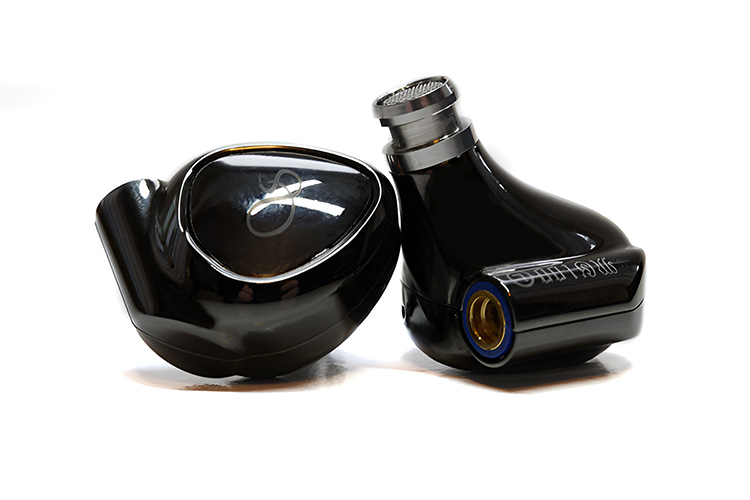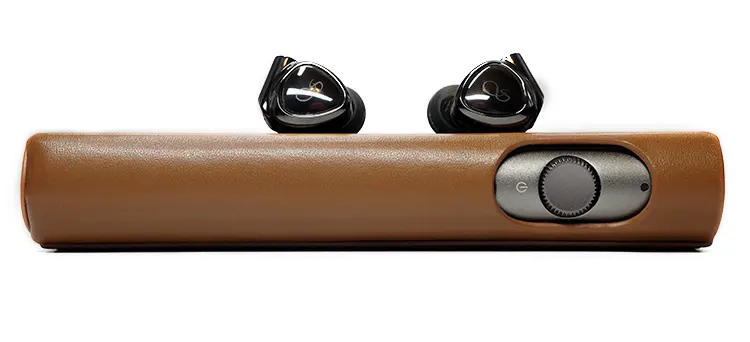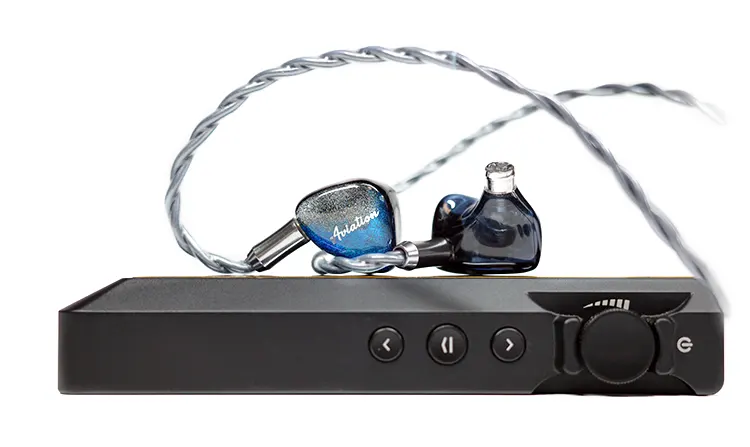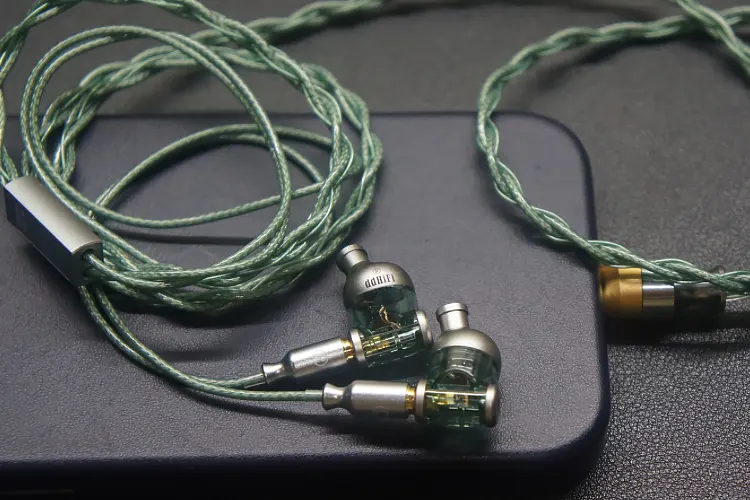Synergy
Efficiency
The MG100 is easy to drive, knowing its low impedance of 16Ω and high sensitivity of 113+/-3db @1kHz.
One would think with that higher-than-normal sensitivity that the background would not be black, and there would be a chance for hiss to be heard. I never heard any hiss between songs, during quiet passages, or when raising the volume. This was quite impressive.
Pairings
The MG100 worked across many sources, due in part to the interchangeable jacks. Using the 4.4mm balanced jack through the Shanling M6 Pro, provided good sound with a bit better soundstage to it.
Energy from the notes was a bit stronger, without losing texture or thickness. The detail was good as well.
Switching to the Cayin N6ii, and the 3.5mm single-ended jack; the sound was still quite good, especially using the brass balanced filter. Detail retrieval benefited from the filter choice, but I found no matter the source or jack, the sound was still quite good.
Select Comparisons
QoA Aviation
Technical
When I previously reviewed the QoA Aviation, I noted the hybrid driver unit was good for certain genres, but indifferent for others. This is a departure from the MG100.
The QoA Aviation is a 4-driver per side universal IEM with a bulbous fitting shell. It houses one dynamic driver. (8mm, full range), and three balanced armatures (dual Knowles 32873 drivers for midrange and treble response, and one Knowles 33518 for the ultra-high frequency band).
The Aviation has a sensitivity of 118 dB @1kHz and a somewhat high (for an IEM) 39Ω impedance rating, but overall, it is a sensitive and fairly easy-to-drive IEM on paper.
Design
The Aviation has a 3D-molded, printed shell smoothed by hand polishing as opposed to the aluminum of the MG100. It comes in two stunning hand-painted colors, Mirage, and Galaxy (our review sample). The typical conch nub is present to help fit inside your ear.
The three-piece unit fits together smoothly due to hand polishing. A vent hole is on the back side, as opposed to the inside, allowing the dynamic driver to breathe.
The silver nozzle has an ornate silver ring around the three-hole patterned sound tubes, which is the first I have seen. Those sound tubes are inset into a molded form and set inside the nozzle ring. I had no trouble wearing the Aviation for long periods.
Performance
The QoA Aviation has a smoother signature than the MG100 and is what I call a bit more mature. There is a good rumble down low, like the MG100; but a bit more untamed. The Aviation’s low end bleeds into the mids, creating that smooth signature, but muddying the overall tonality a bit.
The midrange in planar units is typically the star (along with a resolution to me), and the Aviation does not disappoint. Laid-back and smooth, but with the bass bleed, the Aviation sounds quite rich, but not as distinct and detailed as the MG100.
I mentioned that the Aviation was more genre-specific (jazz), and while that is true, the MG100 provides better clarity to the overall signature making it a more versatile unit, especially with the changeable filters.
ddHiFi Janus3
Technical
The Janus3 is the latest iteration of the highly successful Janus range, following suit with scaled-down technology. This fits into a bracket similar to the MG100 but keeps its uniqueness; paying homage to the heritage of the original.
Featuring a single 10mm ultra-low distortion dynamic driver, the Janus3 is equipped with a lithium magnesium alloy dome composite diaphragm with a rated impedance of 14Ω ± 15% (@1kHz) and a sensitivity level of 122dB/Vrms (@1kHz). This makes the ddHiFi easy enough to drive from a portable setup.
The Janus3 is the result of a collaboration with Moondrop, highlighting a rare inter-manufacturer partnership, leveraging Moondrop’s experience in tuning IEMs.
Additionally, the Janus3 provides a 1.2m cable, which includes interchangeable 3.5mm and 4.4mm plugs. Allowing for seamless compatibility with various audio sources, the 3 caters to a wide range of user preferences and setups; while following the footsteps of other manufacturers who utilize interchangeable jacks.
Design
The Janus3 has the still unique retro-futuristic design philosophy, with a transparent blue shell that reveals the internal components. More plastic is used in this rendition, keeping the price moderate as a result.
The shape of the shell is somewhat unconventional when compared to other IEMs within the price range. The Janus3’s “piston” or “bullet” type shape can be worn as either a simple earbud or a classic IEM with the wire over the ear.
The thinner cable is harder to keep over the ear than previous ddHiFi cables, though; since there is not an ear guide.
The Janus3 makes use of a separate front chamber and rear chamber. The front chamber is constructed from CNC-machined aluminum with a smooth finish, giving it a premium feel.
The rear chamber is constructed out of high-quality plastic material, giving it its transparent blue appearance, and showing off the wire connecting the MMCX port to the single dynamic driver.
Both front and rear chambers have exposed vents, with the one on the front metallic shell being barely noticeable above the nozzle, and the vent on the rear chamber being one of the stand-out design aspects of the unit.
The cable is a very good-looking unit, much like the other offerings from ddHiFi, but the thinness above the splitter makes it too light for use over the ear, in my estimation.
While it did work, the cable came free from my ear a good bit of the time. Wearing the Janus3 like an earbud countered this, with no loss in audio quality, though.
Performance
I am a fan of the Janus line, using the original and Janus2 with upscale Nyx cables, providing me with a good sound, bordered with very good detail retrieval and clarity. Plus, the two are just a fun listen.
The Janus 3 is the company’s scaled-down unit, and to expect the same audio quality is a bit unrealistic. Nevertheless, the Janus3 provides good mids, with vocals (especially female vocals) pushed forward, but thankfully not up.
A smooth signature, but with more energy than the Aviation brings the Janus closer to the MG100’s detail retrieval. Meldrick called the Janus mids “articulate,” which is an excellent description for them.
The bass is tighter, but less pronounced (using the balanced filter on the MG100), providing for a lighter signature. This adds more energy to the overall signature, but the lack of overall clarity still seems lacking when compared to the MG100.
Up top, the Janus3 is rounded off, which to me hinders the air and space for the notes to spread out. Had the tune added a bit more sparkle, this would be a very good end-to-end IEM. There is still good energy to cymbal hits and the speed of decay helps to keep the upper end tight.
I do like the signature, and smooth character, which that rounded treble helps to present, though. That the treble is non-fatiguing, which is good in my mind.
Thieaudio Legacy 2
Technical
The Thieaudio Legacy 2 is a bit older, but still a valid comparison to the MG100 due to the technology involved and the lineage of the Legacy line.
The Legacy 2 uses a combination of 10mm Beryllium dynamic driver + Knowles ED29689 Balanced Armature. The specific selection of this component was an attempt to seize neutrality in the midrange, which is something the Knowles BA is known for offering.
Beyond this, the 10mm dynamic portion was tuned to offer plentiful bass depth and impact. It becomes clear that the intent of the sound signature was planned from the start to provide a specific and tailored sound.
They have also implemented much stronger magnets than in past models, which makes for a livelier signature.
Design
The ThieAudio Legacy 2 is a closed IEM over-ear style much like the MG100, with the cable lead dropping straight down. The ear guide provides good support and did not become dislodged during use.
Usually, over-the-ear styles like this offer more stability and are less prone to fit issues while you are moving around. I prefer the over-ear-guide system because it doesn’t bunch up and I can function better and not worry about the IEM dislodging.
Performance
The low end of the Legacy 2 is powerful and controlled, what with the 10mm dynamic driver; providing a semi-speedy attack and decay, which keeps the notes thick but controlled.
Sub-bass is also controlled, but not elevated to the point where it hinders the mid-range. While not the speediest or bass with the most rumble, the Legacy 2 still provides a good foundation, but less of one than the MG100.
The Knowles BAs provide a conundrum of sorts. Excellent in detail, but seemingly disjointed from the bass, the mids come across as neutral and distinct.
That separation is not a bad thing in this case, since the keeps the bass from injecting any nuances in the low end to inhibit the clarity in those mids.
I have always found Knowles to be quite adequate up top, but some come across with too much sparkle or energy for my taste.
That would be the case in the Legacy 2. That separation from the mostly neutral bass and mids makes for an interesting dichotomy and a semi-disjointed feeling.
I understand why, since that energy up top is used to provide extension and clarity along with a good resolution to the overall signature, but the disconnection between the three is evident here.
The Legacy 2 is a fun, nearly-neutral-sounding IEM let down by a lack of detail in the signature.
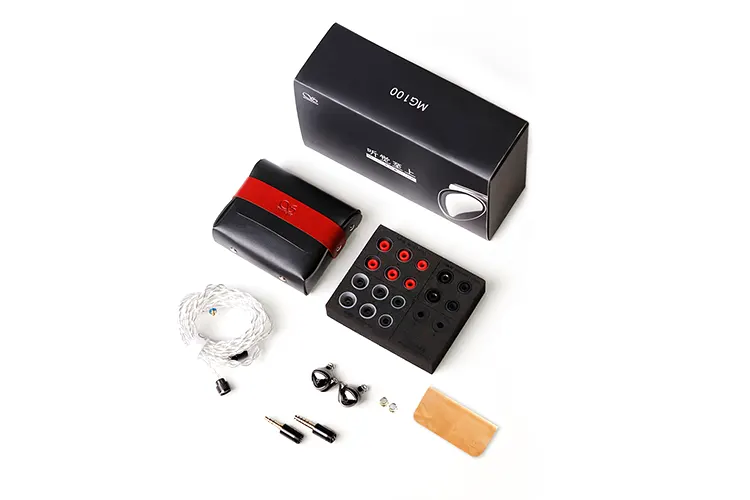
Our Verdict
I found the Shanling MG100 to be a surprisingly good entry-level single dynamic driver IEM. Its competitive edge lies in the duality of its sound signature with those interchangeable filters.
Succinct, detailed sound emanates from the balanced filter, while the stainless steel bass-oriented filter adds thump down below; at the expense of a slight bleed into the mids. No matter, for the sound is energetic and vibrant.
The MG100 is fingerprint-prone, due to the sheen on the shell, but to me, that is a small matter when considering the enjoyable sound signature coming forth. Shanling has produced a competitive performer for not too many greens.
Shanling MG100 Technical Specifications
- Configuration: Single Dynamic Driver
- Driver Size:10mm
- Impedance: 16Ω
- Frequency range: 15-40000Hz
- Sensitivity: 113±3dB
- Cable length: 1.3meters
- Plug: 3.5/4.4mm
- Weight: 5.6g

